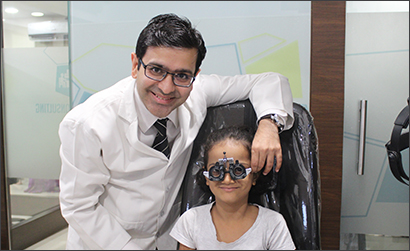
What is a Pediatric Ophthalmologist?
A pediatric ophthalmologist is an ophthalmologist who has undergone further training to understand & treat the eyes and the developing visual system of infants and children. In addition, because the surgical techniques involved in treating strabismus (muscle problems of the eyes) are best learned in a pediatric ophthalmology fellowship, these physicians often treat adult strabismus as well.
Mumbai Eye Care offers comprehensive vision services for pediatric patients and adults with strabismus. Our ophthalmology department has close relations with pediatric specialists, providing a continuity of care for any child with issues related to eyes and vision. Our physicians and staff are trained well to handle children of all age group and are child-friendly. Our up-to-date diagnostic equipment and surgical techniques, and state-of-the art facilities all help us in our mission to provide excellent care for your chil
Common Pediatric Eye Problems
Catract | Strabismus (crossed eyes, wandering eyes) | Nystagmus (shaking eyes) | Lacrimal duct obstructions (blocked tear ducts) Congenital malformations of the eye | Congenital optic nerve problems | Ptosis (droopy eyelid) | Amblyopia (lazy eye)
Pediatric catract
A catract is a cloudiness of the lens of the eye, which is supposed to be crystal clear. Imagine if the clear lens of your camera just turned white. That's basically a catract. Even if the lens just developed a white dot in the middle, it would still be a catract. The whole lens needs to be taken out and replaced with a contact lens (for infants and very young children), or a clear plastic lens (for children who are older).
Around one in 5,000 children are born with a catract. Taken together, congenital and acquired (developing later in life) catracts occur in about .4 percent of children.
Causes of catract amongst children
Congenital (present at birth) catracts occur when the lens didn’t form properly. Acquired catracts are caused by abnormal interactions among the proteins that make up the lens. Over time, these abnormal interactions cause clumping, specks, opacities and/or cloudy areas to form.
About 25 percent of the time, congenital catracts have a genetic cause, and may accompany a metabolic, hormonal or chromosomal abnormality (e.g., Down syndrome). Another 25 percent of the time, catract is hereditary, which means that the child’s mom or dad also had a catract in childhood.
Some possible causes of acquired catracts are:
- Idiopathic (unknown),
- Trauma to the eye,
- Diabetes or another metabolic disease,
- Steroid use,
- Complications from other eye diseases,
- Complications from treatment of other childhood diseases,
-
Radiation therapy after cancer
FAQ's
Also, remember that the eye’s natural lenses can shift focus from distance to near, but implanted plastic lenses can only focus at one place. To compensate for this, we often put children in bifocals once they’re able to sit up. This helps them focus both up close and far away.